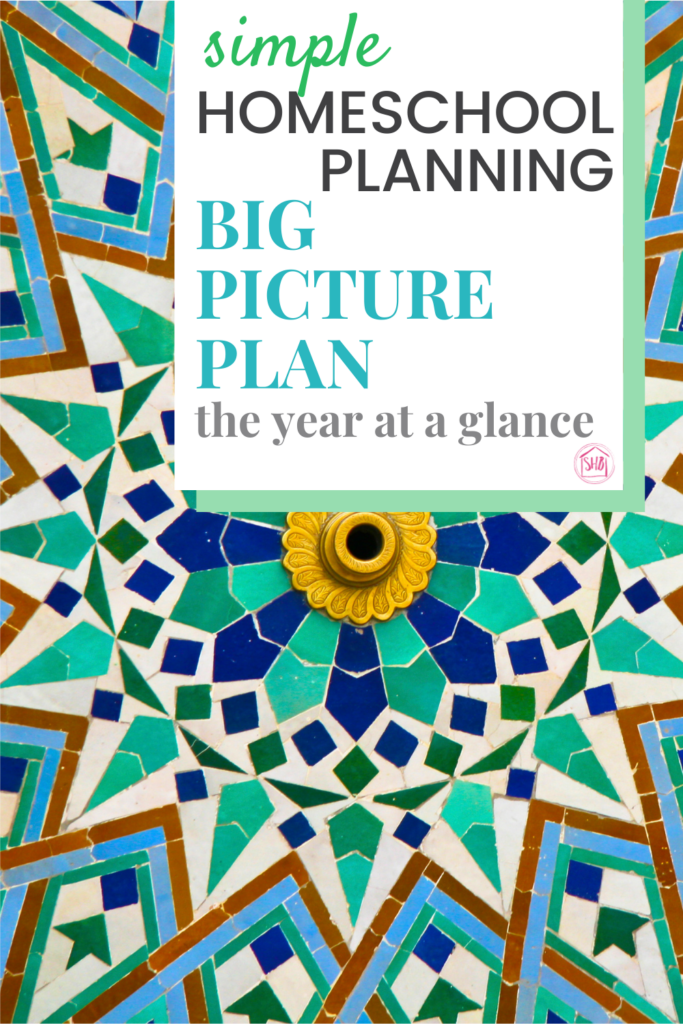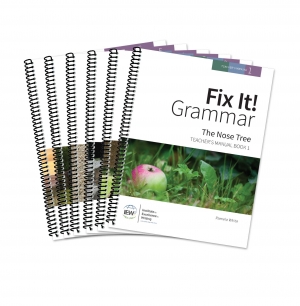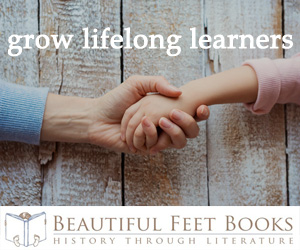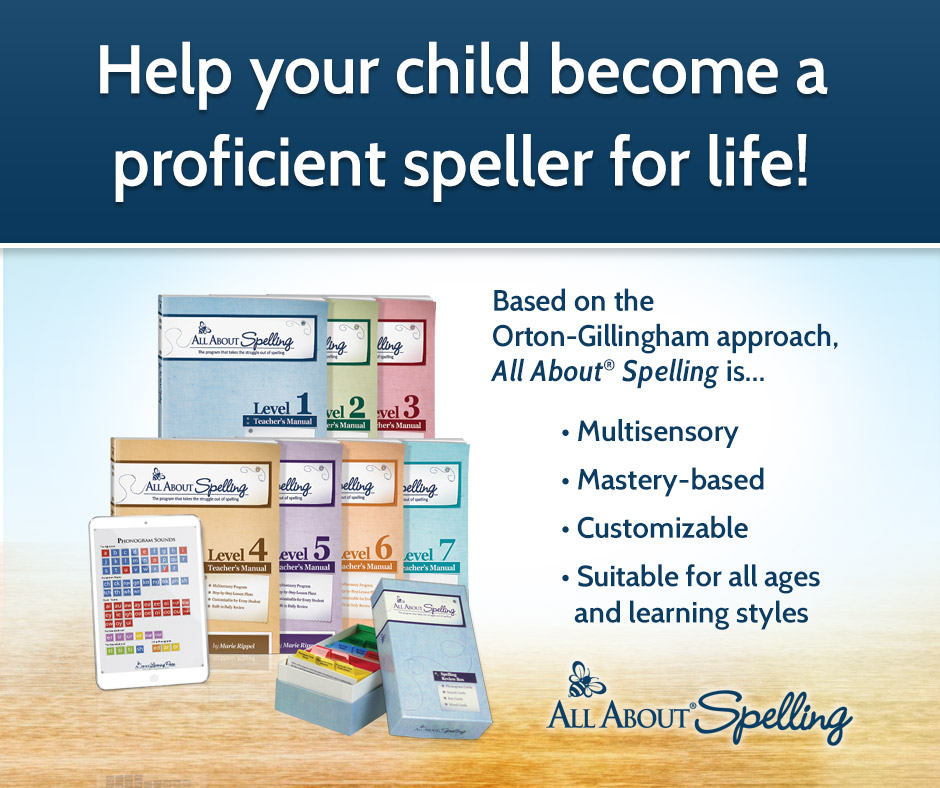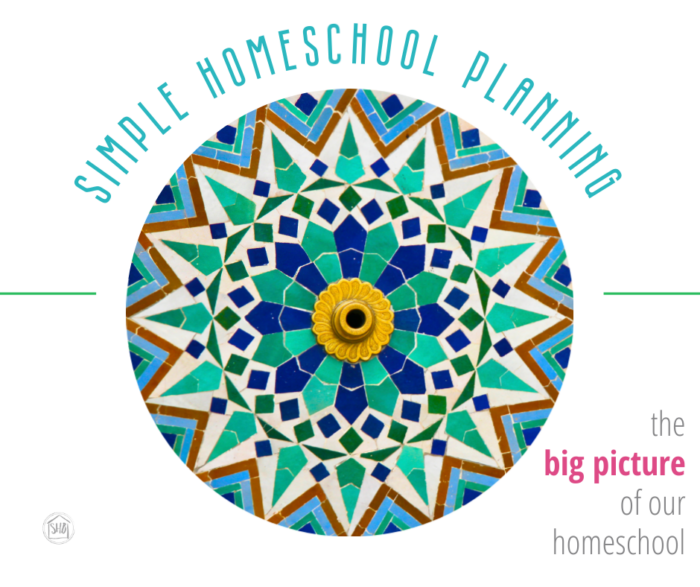
In this series on Homeschool Planning, I have shared the structure of our homeschool year and the pillars for our homeschool. It has been fun to share the ways we use our chosen curricula within the framework of our year. Today, I turn to the big picture planning I do each April as I plan for our year. Later I will share the smaller picture – the week-by-week plan I use throughout the actual school year.
I pray this series is a blessing to you, even if you are a seasoned homeschool mom/teacher. If you have any questions along the way, ask away – I could talk about homeschooling for ages!
This post may include affiliate links. If you click and make a purchase based on my recommendation, I get a small remuneration at no extra expense to you. I only recommend things I use and believe to be a blessing.
Alright, so let’s begin with the beginning of April. I approach my planning from two different places. There is a sort of One Room Schoolhouse – overall plan. And then there are individual student plans, based on grade level and ability.
Resources for Big Picture Planning
I have been using the same planner for the past 3 years. It is available through Mardel.com and works for my large-ish family. I suppose I could lay it out differently and still use it for an even larger family. But it works for my 4-kid family just fine with some room left over for some household and blog planning.
As I mentioned in the previous articles for this series, I also have:
- the Classical Conversations Foundations guide
- the Classical Conversations Essentials of the English Language guide
- PDF schedules from Ambleside Online,
- a set of pens (I am very particular about my pens, these are my current favorite)
- sticky notes and tabs
By the time April starts, I have all these resources at my disposal and I can begin the big picture planning.
The Big Picture Plan for a One Room Schoolhouse
The Classical Conversations material does not change drastically from year to year. Yes, there are three cycles, but we approach the memory work in similar fashion each year. Here’s our weekly schedule for memory work review. And the Essentials program is the same program for each year, with the “easy plus one” approach. So this portion of our homeschool planning is almost already done for us. I just need to decide how much time to dedicate to memory work review and Essentials work each week for the 1st and 2nd terms of our year.
I view my planning for Classical Conversations review as a practice for a one-room schoolhouse. Ideally, every child will be involved in reviewing the memory work each week. We tend to be a little better about making this happen in term 2 of our school year. And we do not formally review CC memory work in the summer term (term 3).
In my planning for Classical Conversations for the entire school, I will come up with and search out resources to use in review. I have mentioned before I always purchase the Amy Snyder resources and make a memory work review book for each child. If I do not find resources I think will be suitable for review, I create resources for us to do together. Many of these resources have become useful resources available in the Classical Conversations section of our shop.
Any other one-room schoolhouse opportunities are noted as I go through the individual student planning and as I plan the Gathering for the year. I simply make notes on post-its of where I have some resource I want to share with my students. Latin learning is something I want to get in during our one room schoolhouse. So, I create a sort of loose schedule for our Latin Gathering – I call it Conlatio.
Big Picture Planning – Individual Students
Instead of planning the entire homeschool picture at once, I start with one student. Usually, I pick my oldest student, so I can be sure to keep in mind one-room schoolhouse opportunities as I go. My oldest two students are very close in age and less than a year apart in school. Individual plans for the school year rely heavily on the Ambleside Online book lists and schedules. There are few books from the lists we do not include in our homeschool in some way.
I sat down in last year’s planning session and did a long-term plan to put my two oldest students together when the younger of the two is in 4th grade. This required me to extensively evaluate the Ambleside Online reading lists/schedules for years 3, 3.5, 4, 5 and groups form 2. It was a lot! Thankfully this will only have to be done one time. I view the planning I did last year and the intervening years until they are in the “same grade” as a sort of on-ramp to smoother homeschool planning.
Wow! That got complicated quickly. I hope that made sense. Eventually, I will be planning for two students at a time and then the younger students separately. But for now, I start with one student at a time. If you have students who are close in age and ability and you are looking to put them together eventually; you might want to start out looking at Ambleside Online’s reading lists/schedules for Groups.
Evaluating the AO List & Schedules
So, I sit down with the book lists and the PDF schedule for the year my individual student will be working in the next year. I evaluate a number of things as I select which books to include and when:
- Will this book appeal to my student?
- Does this fit into our homeschool?
- Can I find a suitable replacement for the list book? (on another list or in my shelves)
- Do I want to read this book?
These can be arbitrary, I know. But that is the beauty of planning which books to read and when. I love being the teacher!
Once I have decided which books we will be using, I highlight them on the PDF schedule I printed out and look at the specific schedule for each book. This is where Ambleside Online excels – the Charlotte Mason approach to reading – savoring. Rarely do I notice a book too quickly paced. Instead books are spread over weeks, months, and in some cases years.
Year 4 and Essentials
As we have gotten into Year 4 of AO and beyond, I have started to notice the stretch between AO and CC has broadened. That is to say, there is a point at which I will have to choose one or the other. The bridge I am able to build between the two starts getting longer and more roughly hewn. One day we will not be able to cross the bridge anymore, we will be left standing on one bank of the river or the other. Thankfully, they both have left behind practical riches which we can continue to use forever.
When we got to year 4, I knew we would not be able to read every book on the list – we just didn’t have the time. (In the case of Robinson Crusoe, the inclination). The stack of books in the years subsequent to Year 4 just get taller. Although CC does not start requiring reading for another 3 years (at least), they do offer some book recommendations which fit the cycle and are living books, too. Those are some of the books I have substituted for books I am not interested in reading in AO.
As I planned this year for next year, I started to build that Bridge I mentioned a little stronger. I realized my desire for my students to have a more-fully immersive learning experience as we walk through the Essentials or upper elementary years. As such, I started piecing together a plan. I am calling it the Bridge. You can read more about it here.
Big Picture Planning – A Peek Inside my Planner
Inside my planner you will notice I have listed the subjects I cover in my homeschool on the left column. Each day of the week has a box for each subject. I split each of those boxes into sections for my individual students.
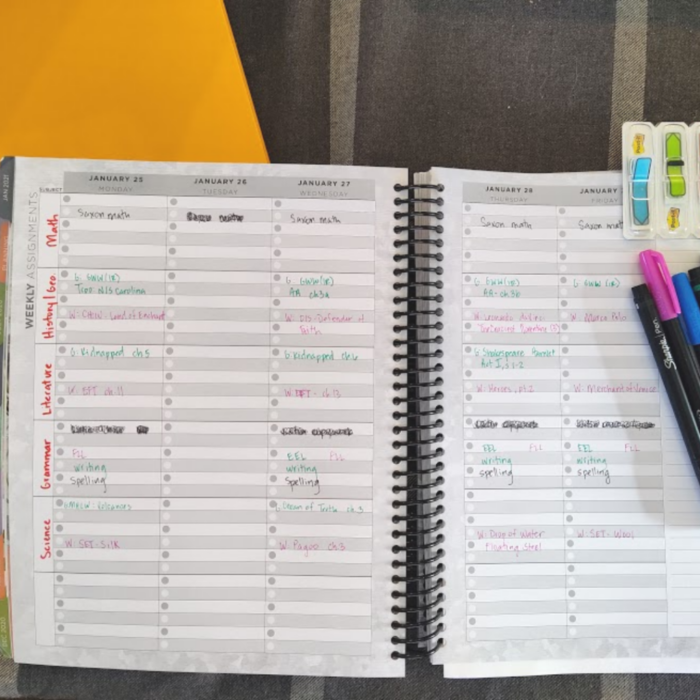
Note: I do not include my two youngest learners because I am walking them through their various programs step-by-step. They do not have a custom plan, so it is super easy to know what the next step is.
Often I use a color coded system for the students. The assignments for each will be coded to the same color throughout the year. Sometimes I forget to do this or misplace that color pen, but I largely stick to the system.
You will notice there is a blank day for Tuesday. This actually got switched at the beginning of the school year after our CC community day got changed to Monday. Of course, this is not a problem for my schedule because everything is just a placeholder until the week or month of.
I take the assignments I have chosen for my students (from AO reading and my chosen curricula) and simply lay them out on the days of the week until I have everything laid out. Again, these are just placeholders. I do this to make sure I am getting around to all the subjects. I can glance at my weekly spread and see if one of my students has a light or a heavy week in a subject and I can attempt to balance it out.
Big Picture Planning – Individual Subjects
There are a number of subjects for our year which require some additional planning. Shakespeare comes to top of mind. Once a student is in Year 4, Ambleside Online recommends she read one of the Bard’s plays each term. This is our first year of doing this and we are enjoying it immensely.
Last year, I took the time to look at the three plays for this year: A Midsummer Night’s Dream, Hamlet, and Much Ado About Nothing. I created some rough schedules for each play. We have followed this quite easily this year and I will continue to do this as a part of my big picture planning each April for the foreseeable future.
I also did this for Latin this past year, but then reworked it into our Latin Gathering.
